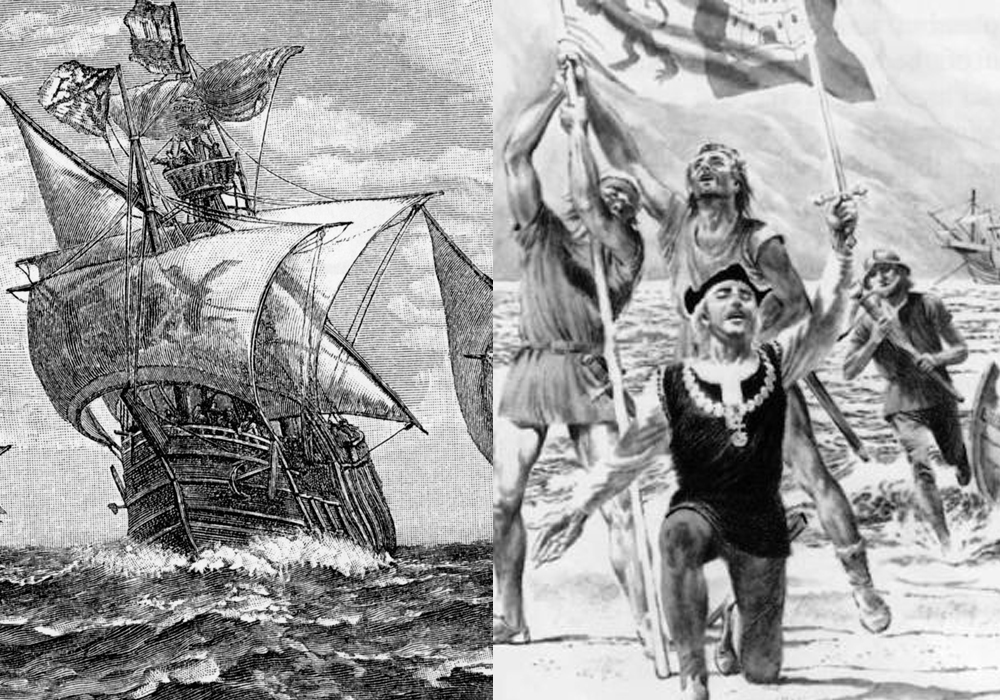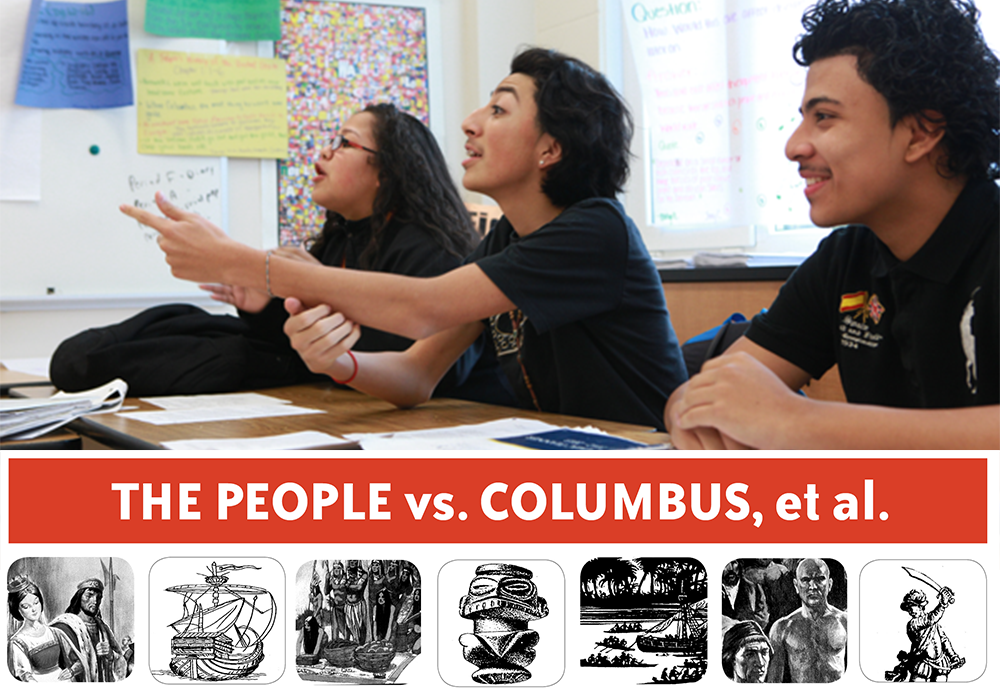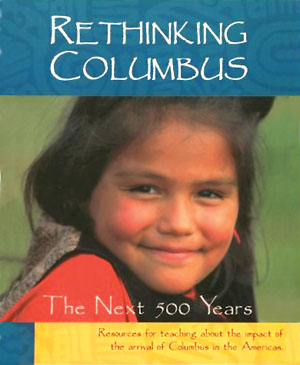Before Enslaving and Slaughtering Them, Columbus wrote: “The Taíno people are ‘the best people in the world, and beyond all the mildest… a people so full of love and without greed… They love their neighbors as themselves, and they have the softest and gentlest voices in the world, and they are always smiling.'”
Early in my high school U.S. history classes, I would ask students about “that guy some people say discovered America.” All my students knew that the correct answer was Christopher Columbus, and every time I asked this question, some student would break into the sing-song rhyme, “In Fourteen Hundred and Ninety-two, Columbus sailed the ocean blue” — and others would join in.
“Right. So who did he supposedly discover?” I asked.
In almost 30 years of teaching, the best anyone could come up with was: “Indians.”
I brushed that answer away: “Yes, but be specific. What were their names? Which nationality?” I never had a student say, “The Taínos.”
“So what does this tell us?” I asked. “What does it say that we all know Columbus’s name, but none of us knows the nationality of the people who were here first? And there were millions of them.”
This erasure of huge swaths of humanity is a fundamental feature of the school curriculum, but also of the broader mainstream political discourse. We usually think about the curriculum as what is taught in school. But as important — perhaps more important — is what is not taught, which includes the lives rendered invisible. Young people, and the rest of us, become inured to the way in which certain people’s lives don’t count, the way in which the world is cleaved in two: between the worthy and the unworthy, those who matter and those who don’t. The “don’t matter” people are the ones the Uruguayan writer Eduardo Galeano called los nadies, the nobodies — “Who speak no languages, only dialects. Who have no religions, only superstitions. Who have no arts, only crafts.”
For the Taíno people of the Caribbean, their erasure began almost immediately, with Columbus’s arrival. It was not curricular, it was flesh and blood. “With 50 men we could subjugate them all and make them do whatever we want,” Columbus wrote in his journal on his third day in the Americas. In 1494, Columbus launched the transatlantic slave trade, sending at least two dozen enslaved Taínos to Spain, “men and women, boys and girls,” as he wrote. The next year, 1495, Columbus launched massive slave raids, rounding up 1,600 Taínos, from which the “best” 500, perhaps 550, were selected to be shipped to Spain. Of the hundreds of captives left over, “whoever wanted them could take as many as he pleased,” one eyewitness, a Spanish colonist, Michele de Cuneo, wrote, “and this was done.”
The Spanish priest Bartolomé de las Casas described what he called the “terror” launched by Columbus in his quest for gold and to suppress Taíno resistance:
It was a general rule among Spaniards to be cruel; not just cruel, but extraordinarily cruel so that harsh and bitter treatment would prevent Indians as daring to think of themselves as human beings or having a minute to think at all. So they would cut an Indian’s hands and leave them dangling by a shred of skin and they would send him on saying, “Go now, spread the news to your chiefs.” They would test their swords and their manly strength on captured Indians and place bets on the slicing off of heads or the cutting of bodies in half with one blow. They burned or hanged captured chiefs.
My students and I read and talked about this erasure — these horrific attacks on Taínos who might dare “to think of themselves as human beings.” Because Columbus’s policies of enslavement, terrorism, and ultimately, mass murder are so egregious, it’s tempting to focus only on Taíno deaths. But those deaths can seem abstract and distant, unless we learn something about Taíno lives.
Ceramic vessel with tortoise representation. Many Taíno objects are in the shape of turtles, an important animal in Taíno creation myths. Source: Taíno Museum. See more artifacts and learn about the museum.
It has always struck me that Columbus himself expressed much more curiosity about the Taínos than one finds in corporate-produced textbooks — although in recent years, no doubt because of Indigenous activism, textbook publishers have discovered the Taínos, if only briefly and superficially. The Taínos were not literate, in the conventional sense, and so wrote nothing about themselves, but Columbus’s journal offers intriguing, if limited, details. In the journal of his first voyage, Columbus wrote about the Taíno people’s homes: “Inside, they were well swept and clean, and their furnishing very well arranged; all were made of very beautiful palm branches.” He said there were “wild birds, tamed, in their houses; there were wonderful outfits of nets and hooks and fishing-tackle.” Columbus writes that it was a “delight” to see Taino canoas (canoes) that were “very beautiful and carved… it was a pleasure to see its workmanship and beauty.” After a little more than three months traveling from island to island, Columbus concluded that the Taíno people are “the best people in the world, and beyond all the mildest… a people so full of love and without greed… They love their neighbors as themselves, and they have the softest and gentlest voices in the world, and they are always smiling.”
Of course, Columbus’s curiosity was grounded in his single-minded quest for gold, and how he might exploit the Taínos to further that mission. As Columbus later wrote King Ferdinand and Queen Isabella: “Gold is a wonderful thing! Whoever owns it is lord of all he wants. With gold it is even possible for souls to open the way to paradise.”
Columbus’s portrait of the mild, soft, and gentle Taíno may conceal that they also tenaciously resisted the Columbus regime, once its exploitative and deadly nature became clear. This resistance has been called the first anti-colonial guerrilla war in the Americas. It began as early as Columbus’s first trip back to Spain, when he left 39 Spaniards at his La Navidad settlement, confident that the powerful Spaniards could handle the supposedly timid Taínos. In response to the Spaniards’ rapacity, the Taínos killed all 39 Spaniards, and burned their fort.
If Columbus’s first trip, with three vessels and maybe 100 men, was an exploratory probe, the second trip, with 17 ships and between 1,200 and 1,500 men, was a full-scale invasion. When slavery turned out not to be profitable on la Española (the island that today is Haiti and the Dominican Republic), Columbus instituted a tribute system for the Taínos, demanding quotas of gold and cotton, with sadistic punishments for those who failed to comply. This system was “impossible and intolerable,” wrote Bartolomé de las Casas.

The Taínos fought back, raiding Spanish forts and killing defenders. Taíno caciques, leaders, worked to build alliances throughout the island. The Taínos continuously resisted the heavily armed Spaniards for almost a year, from May 1495 to March 1496, but uprisings and resistance continued through 1503. According to Spanish accounts, Taínos also went on strike and turned to sabotage. One Spanish eyewitness wrote that the Taínos “thought they might expel [the Spaniards] by creating a scarcity of food. They therefore decided not only to plant no more crops, but also to destroy and tear up all the various kinds of cereals used for bread which had already been sown.” Las Casas adds that the Taínos “would hide in the mountains,” but when they “fled the Christians, there went with them disease, death, and misery, and an infinite number of fathers and mothers and children died in anguish.”
Ironically, in their quest for a happy ending to this grim first chapter in European colonialism in the Americas, textbook writers also focus on food — but not on resistance. For example, Houghton Mifflin Harcourt’s middle school text United States History Early Years concludes its section on Columbus:
The Columbian Exchange benefited people all over the world. Potatoes from the Americas became an important food for most Europeans. Corn became an important crop in Africa. Sweet potatoes were grown as far away as China. Today, tomatoes, peanuts, and American beans and peppers are grown in many lands.
The sole “review” question asks: “How did the Columbian Exchange change the diet of Europeans?”
This is how the textbook story ends: wondering about the eating habits of Europeans. Let’s remember that enslaving Africans and shipping them to the Americas was also a part of the so-called Columbian Exchange. Africa was not only a receptacle for American corn. Columbus was granted the first royal permit to bring enslaved Africans to the Americas in 1501, less than a decade after his arrival.

Despite textbook attempts to conclude the story with a smiley-face, there is no happy ending. But there is a hopeful one — found in the remarkable resilience of the Taíno people. Contrary to some scholarship, the Taínos were not all killed off by Columbus and subsequent occupiers, and today members of the Taíno diaspora along with people in the Caribbean who claim Taíno ancestry are reviving and celebrating their culture. According to Christina M. González, writing in the fall 2018 issue of American Indian, the Taíno revival began around the quincentenary of Columbus’s arrival. The renaissance focuses on language, art, religion, pharmacology, agriculture, fishing, cooking, and, of course, rethinking Taíno history. González writes, “Many in the movement call upon embodied memories of traditions and values disseminated across generations, often by family matriarchs, which espoused mindful relations in a world where all things have life, from plants, stones, rivers, forests, caves, sun and moon, to deceased relatives and disincarnate beings inhabiting their islands.”
In recent years, genetic research has confirmed the ongoing Taíno presence in the Caribbean. According to José Barreiro, a scholar and a member of the Taíno Nation of the Antilles, genetic research in Cuba has found that almost 35 percent of Cubans have Native American mitochondrial DNA, with some regions as high as 59 percent. A University of Puerto Rico study of 800 randomly selected Puerto Ricans found 61.1 percent of individuals surveyed had mitochondrial DNA of Indigenous origin. But as a friend recently reminded me, people with Taíno cultural DNA had no need for scientific confirmation that they are still here — “hidden in plain sight,” as José Barreiro subtitled his National Museum of the American Indian article on “Indigenous Cuba.”
Columbus’s treatment of the Taíno people meets the UN definition of genocide. But there has also been a curricular genocide — erasing the memory of the Taíno from our nation’s classrooms. How else can we explain students’ universal recognition of Columbus and almost total ignorance of the name Taíno? As we work to replace Columbus Day with Indigenous Peoples Day in our communities and schools, let’s work to remember the people who were here first. Their lives mattered 500 years ago, and they matter today.
Bill Bigelow is curriculum editor of Rethinking Schools magazine and co-director of the Zinn Education Project. He the author and co-editor of numerous publications including Rethinking Columbus: The Next 500 Years and A People’s Curriculum for the Earth: Teaching Climate Change and the Environmental Crisis.
Related Resources

Abolish Columbus Day Campaign
In solidarity with Indigenous peoples throughout the world, the Zinn Education Project has joined the campaign to Abolish Columbus Day. Celebrating Columbus means celebrating colonialism, celebrating racism, celebrating genocide. It’s time that instead we paid tribute to the people who were here first, who are still here, and who are leading the struggle for a sustainable planet.

Discovering Columbus: Re-reading the Past
Teaching Activity. By Bill Bigelow.
How to engage students in a critical analysis of the textbook version of “discovery.”

The People vs. Columbus, et al.
Teaching Activity. By Bill Bigelow. 8 pages.
Role play in the form of a trial to determine who is responsible for the death of millions of Taínos on the island of Hispaniola in the late 15th century. Roles available in Spanish.

Rethinking Columbus: The Next 500 Years
Teaching Guide. Edited by Bill Bigelow and Bob Peterson. 2003.
Readings and lessons for grades 5 to 12 about the impact and legacy of the arrival of Columbus in the Americas.

An Indigenous Peoples’ History of the United States
Book – Non-fiction. By Roxanne Dunbar-Ortiz. 2015.
Four hundred years of Native American history from a bottom-up perspective.

Columbus in America
Film. By Paul Puglisi. 2017. 89 min.
Documentary on the symbol of Columbus in the United States and the campaign for Indigenous Peoples Day.



